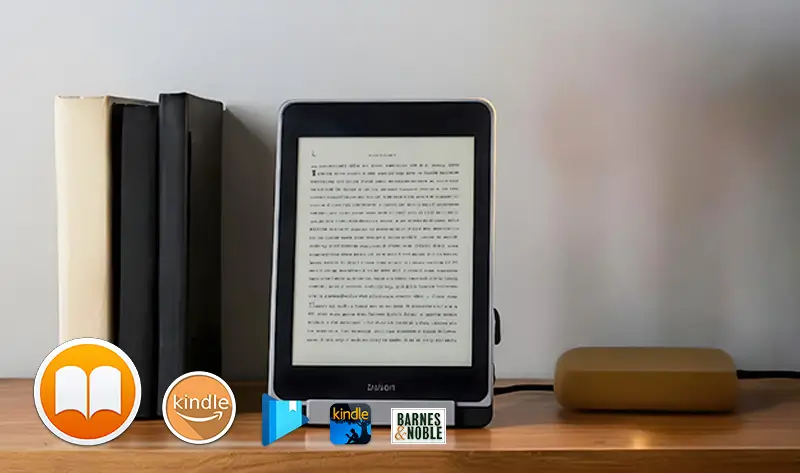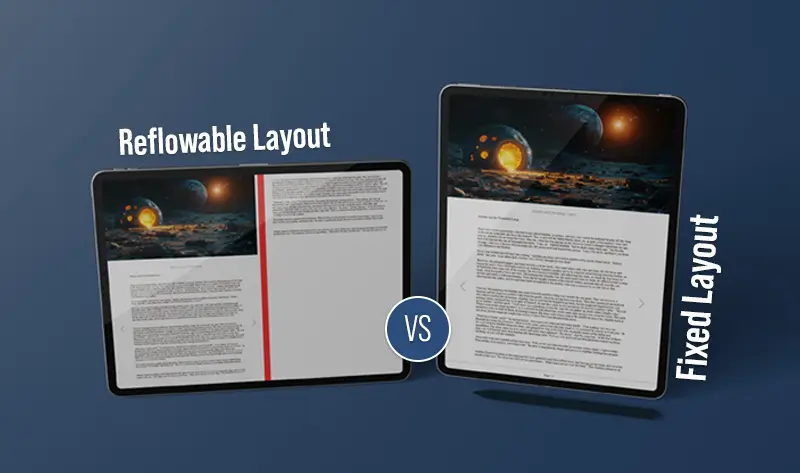How to Self-Publish an eBook in 9 Steps (2025)
An eBook is a book in digital form that you can read on your smartphone, tablet, computer, or eReader. Because these are much easier to make and publish than physical books, plenty of authors have turned to self-publishing.
So, what does it mean to self-publish a book?
Self-publishing is when you, the author, publish your written work by yourself, either as an eBook or a physical book made using print-on-demand services. Basically, you’re an independent or indie author with no external publisher handling all the responsibilities and expenses related to the publishing process.

How is self-publishing different from traditional book publishing?
In the traditional process, a publisher publishes your written work on your behalf. They bear the expenses, prepare the cover, format the book, and promote the book. However, the rights to the book and royalties go to the publisher. In some cases, they have creative direction as well.
In self-publishing, however, everything is in your hands. You decide what to write, the cover design, where to publish, how to promote, and so on. You have complete creative freedom, although you may have to follow some guidelines prescribed by the eBook publishing platform you have chosen to use.
Here’s a brief overview of how different self-publishing is from the traditional method of going through a publishing house:
- You have the freedom to set the book price.
- You can keep all the rights to your book, so it is easier for you to have a final say on any future movies, TV shows, etc., that may want to use all or any part of your work.
- All the royalties go to you.
- You can take as much time as you want to complete the book. There is no external publisher who will pressure you to complete your book by a particular deadline.
- As an independent author, you must invest time and your own money into promoting your book. For this very reason, many authors have a website and an account on all prominent social media sites.
- You don’t have to worry about pitching your book to different publishers, hoping that at least one of them will pick it up.
- Unless you are a well-known author, you might find it challenging to get on a bestseller list without the help of a publisher.
With this firm understanding of what it means to be an indie author, let’s look at how you can publish your eBook.
Steps on how to self-publish an eBook
Step 1: Write your book
Naturally, you first need to write the book and prepare all the other pages (like the table of contents, prologues, foreword, etc.) before you begin the publishing process. If your book needs visuals, get them prepared and include them wherever necessary.
Always write with the reader in mind. It, in no way, hampers your writing, but it does improve your chances of impressing a reader when you write with a target group in mind. For example, books like Harry Potter, Divergent, and Twilight are aimed at young-adults, which is why they are classified as young-adult novels.
These are the things you need to figure out:
- What is the age of your readers?
- What do people of that age enjoy reading?
- What can your reader expect from your book?
- What genre of books does your reader prefer?
If narrative-related breaks are natural, you can consider serializing the content. It offers additional promotional options and maximizes the revenue-generating potential of your content. Consider making the first edition of your eBook series free to generate excitement and curiosity among readers. They will be willing to pay for the next versions if your content is exciting.
Step 2: Proofread and edit the content
Step 3: Choose your publishing platform

Self-publishers are in luck today, as there are so many online publishing platforms where you can publish your book. The even better news is that many of them are free, although some of them can charge a fee or commission on the sales of your book. Here are some of the most popular eBook publishing platforms:
Step 4: Select the appropriate book format

For online book publishing, you have to choose eBook file formats depending on the content type used for eBooks and the platform on which you want to sell.
The reflowable content is ideal for text-rich eBooks and novels. The resizing and scaling of the text are done spontaneously to ensure optimum legibility. As a result, the content flows from one page to the next. You can sell the reflowable eBooks through Blurb on the Apple iBooks Store or Amazon Kindle Store.
If your eBook is enhanced, i.e., it contains multimedia content or rich illustrations, you must go with a fixed layout. The content remains confined to the pre-defined page layout, which facilitates the preservation of design elements. The fixed-layout eBooks can be sold on the Apple iBooks Store, Amazon, and Blurb Bookstore.
The fixed format is not as widely used as the reflowable format, but it does have its uses. The fixed format gives you more control and uniformity in how your book appears on different devices and orientations. It is also extremely useful when you want to overlay interactive elements over each other. For example, incorporating audio into book illustrations so the sounds play when the reader touches the image, like in children’s books.
Step 5: Create an eye-catching cover design

Any book needs to have an attractive cover design to grab the reader’s attention. The design needs to match the whole theme of the book and the story it is telling. If your book is part of a series, it can have some elements that link it with the others.
As a self-publisher, you can design your book cover in any way, but there are some crucial elements you must include:
Front cover Book title Subtitle Author’s name Attractive visuals Spine Book title Author’s name Back cover Book title Subtitle Author’s name Synopsis Author bio (along with your picture) Reviews/endorsements Step 6: Increase visibility by using metadata
The author's name, biography, title and description are referred to as "book metadata " to help potential readers locate your book. Internet search engines use keywords to direct users to relevant products or information. These pertinent keywords should thus be included in your content's metadata.
Do complete research on what key phrases you would use to discover an eBook you self-published. After that, list 15 to 20 words or phrases that are more particular. Then, search Amazon to determine the applicability of each. Lastly, incorporate all keywords into your book description, author bio, and potentially even title or sub-title.
-
Step 7: Finalize the price
Before finalizing your eBook’s price, you need to look at the prices at which eBooks similar to yours are listed on your favorite eBook publishing platforms. It would help you make a ballpark estimate of the price you should be quoting.
Of course, you can even list your eBooks for free if your aim is to slowly grow your reader base. Sometimes, people like picking up free books to get a good understanding of the author’s creativity and storytelling abilities. If they like the book, they will be more likely to buy a book from the same author later.
-
Step 8: Engage in proper marketing
You can create an official website for marketing purposes. It allows you to create a mailing list of followers, create an author brand, and, most crucially, give direct links to stores that sell your book.
Additionally, it would help if you used your social media presence to promote your e-book even before it was released. To generate interest and anticipation, publish a series of blog entries about the subject of your book or post teasers that include quotes or illustrations.
-
Step 9: Publish the eBook
Several things have to be considered when you talk about eBook publishing. Some companies pitch their eBook conversion services to authors or publishers in return for a price. You can avail of an all-inclusive digital conversion service, starting with initial manuscript to eBook conversion, eBook formatting, and eBook copyediting.
You have to choose from the available eBook conversion companies based on their unique approaches to authors.
You need to differentiate between authentic and vanity publishing services, as editing, cover design, and other publishing-related processes are costly. It would help if you were wary of companies that ask for money to publish an eBook but refuse to disclose how the money will be spent. Once you have entered into a return agreement, getting out can be difficult.
If you’re choosing to do everything by yourself, you can follow the guidelines given by the website you have chosen, upload your book, and publish it. And, you’re done!
Second, you must thoroughly edit and proofread the content. Consider double-checking the pages by yourself or outsource to professionals that offer eBook proofreading services (like an agency or freelance editors). When readers encounter several errors in your writing for the first time, they might easily lose interest and stop reading. Work with a professional editor, a fellow author, or a friend with adequate expertise, to evaluate consistency and flow in addition to the standard spelling and grammatical checks.
Over to you now
Book publishing, even when you do it through an external publisher, is nerve-wracking enough. It can be even more intimidating for self-publishers (especially if you are new). Even veteran authors need help from time to time. To that end, this eBook self-publishing guide should arm you with enough confidence and information for a smooth journey as an independent author.







